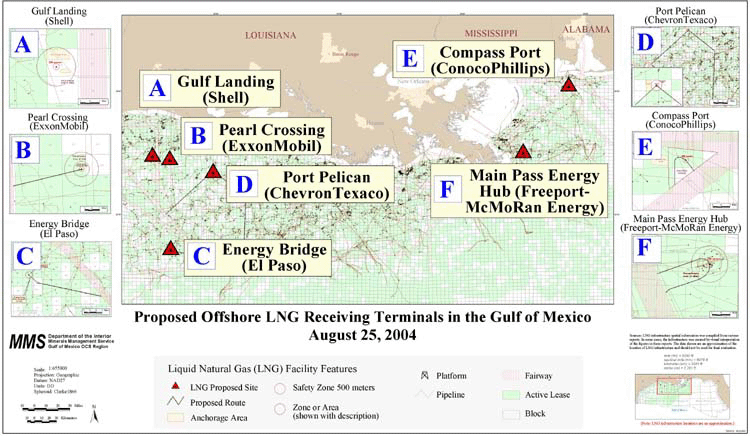The large-scale map below shows the “preferred alternative” locations for each of the proposed LNG receiving terminals within the offshore areas of the Gulf of Mexico. Each deepwater port application also includes “other alternative” terminal site(s) that are proposed by the applicant and are considered and evaluated in the corresponding National Environmental Policy Act (NEPA) documents. These “other alternatives” are not depicted in this map. Readers are advised to review the individual deepwater port applications for specific information regarding all of the alternatives considered and their respective locations.
To provide discernable information on each proposed terminal site, smaller scaled maps are included for each of the proposed projects. The reader can discern lease status and existing infrastructure information proximal to the proposed terminals.
For security and safety reasons, there are several zones proposed around each of the potential terminals. The first is a 500-m Safety Zone that may be established and enforced by the U.S. Coast Guard. This zone would exclude all unauthorized vessels from entering the designated area at any time. This zone would be demarcated on navigational charts of the area. Note that for all applications received thus far, the 500-m zone is wholly contained within the block designated for the terminal’s proposed location. The second zone is a “precautionary area” of varying dimensions [from 2 km (1.2
mi) to 2 mi or larger] that is proposed for all terminals. This area would also be demarcated on navigational charts. It advises mariners that a LNG carrier and/or support vessels may be operating in the area. Note that this zone may impinge on portions of adjacent blocks; however, there are no regulatory restrictions associated with this precautionary area. The purpose of this zone is to minimize the potential for collisions or other impacts with LNG carriers and support vessels by other marine traffic in the vicinity of the terminal.
The maps also include applicant-described recommended LNG carrier vessel routes to and from the proposed terminals. Note that these routes are not proposed as formal fairways but are general routes for the LNG carriers to “call” on the LNG receiving terminals. Recommended routes could appear on navigational charts as inbound and outbound arrows. However, no regulatory restrictions would be associated with these recommended routes.
Disclaimer
The maps included in these web pages are derived from information provided by each applicant in its submittal to the U.S. Coast Guard and the Maritime Administration for compliance with the Deepwater Ports Act, as amended. Locations on the maps are approximate and may be subject to change. Therefore, the maps should be used for planning purposes only. Readers are advised to examine the individual filings for specific information regarding each project.
Download maps |
| pdf file |
 This file is in Adobe Acrobat's pdf format and can be downloaded, read and printed using the free Acrobat Reader. This file is in Adobe Acrobat's pdf format and can be downloaded, read and printed using the free Acrobat Reader. |
| zipped postscript file |
This is an enhanced Postscript plot files generated by ArcView GIS 3.3. Version 9.0 of WINZIP Quick Pick was used to compress this file. Please read our
disclaimer prior to downloading files. |
|
Proposed Offshore LNG Receiving Terminals in the Gulf of Mexico
|
CLICK ON A NAME TO OPEN THE MAP.

|






